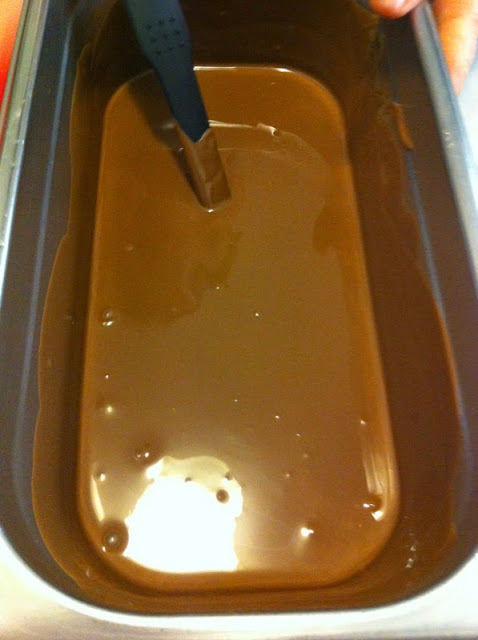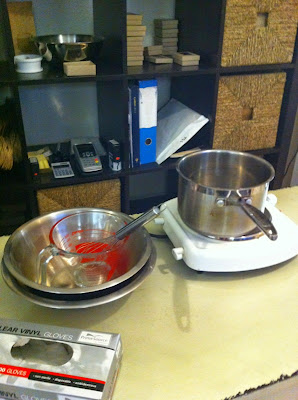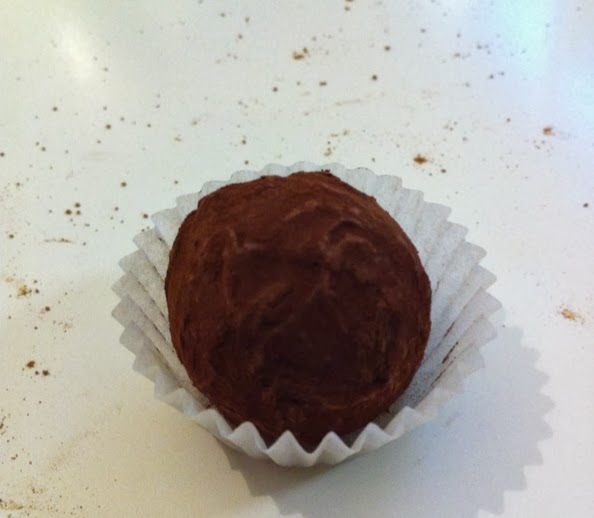“Go on,” says Sue.
I’m about to pour a couple of litres of melted
chocolate all over a flat-topped table, not, you understand, because I’ve
suddenly lost my mind and taken to doing impromptu Jackson Pollock impersonations in the kitchen, but because I’ve been
asked to do it. That’s right - it’s a requirement. And I’m hesitating.
I’m back at Sue Lewis’ Subiaco shop to take the chocolate
class that I’ve been promising myself for months and I’m a bit self-conscious
when she hands me the container, telling me to invert it. I have inhibitions
which scream ‘keep your workspace tidy’. Sue has none.
“All over the table,” she says, “Go on” and when she says
‘Go on’ she makes it sound like, “I dare you.”
 |
| I don't look as nervous as I felt. |
I tip the container. The chocolate flows and pools. The joy I experience at seeing this happen, in making this happen, reminds
me of first reading about the chocolate waterfall in ‘Charlie and the Chocolate Factory”. I walk up
and down, zig-zagging a trail as I go, while my classmates get in
behind me and smooth the chocolate all over the surface with spatulas. When the whole
table is covered, we use paddles to scrape it back into the centre
and then smooth it out all over again.
 |
| Ready with the spatulas! |
I have a sudden urge to giggle and I’m not sure whether
it’s because I’m playing with chocolate, listening to Sue’s jokes (she tells a
good one about a baby polar bear), or drinking champagne. We were welcomed with
glasses of bubbly and it’s probably a good thing that you can’t be arrested for
pouring chocolate under the influence.
 |
| Off to a really good start. |
We’re tempering chocolate on the slab, but that’s not the
only activity we’ve done tonight. The three hour introductory class begins with
tasting. We sample cocoa in all its forms – nibs, powder, mass, butter – while Sue
talks us through the history and chemistry of chocolate production. Her
overview is interesting and educational. I appreciate
the way she explains the processes in laymen’s terms but without dumbing things
down. The descriptions come alive in the cocoa-fragrant warmth of Sue's kitchen. I learn new vocabulary: conching
does indeed relate to the word for the sea-shell, but nibs have nothing to do with pencils even though that is exactly
what I think they look like.
 |
| Nibs are on the right - they *do* look like pencils! |
Tasting chocolate is just like tasting wine and I feel a
little shy as I try to analyse the exotic morsels – from Madagascar, from
Ecuador, from Papua New Guinea – that Sue gives us. I test my language along
with my taste-buds. What is the mouth-feel? Where is the chocolate experienced in
the palate? How would you describe it: bitter, tangy, alkaline, citrusy,
fruity, light, dense?
 |
| Truffles and powder. |
“Can I say ‘vinegary’?” I ask. That sounds so wrong –
surely you can’t talk about chocolate in those terms and I’ve just done so in
front of an expert. How embarrassing.
“Of course you can,” says Sue, and proceeds to tell me
about some chocolate she tried once that tasted so intensely of vinegar that it
brought tears to her eyes. Reassured, I continue to explore, becoming more
confident with my descriptions. Sue is generous with her samples and this time
when she says “Go on” she means “Have some more.”
 |
| Cocoa mass. |
I’m the only person in this evening's class who doesn’t
have any formal training in cake-making or patisserie. The one thing we have in common is a love-affair with chocolate – our theobromance. Otherwise, I’m
as a rank an amateur as you can imagine, so when it’s time to make the ganache,
I think it has to contain cream. The term ‘water-based’ is
new to me.
“What do you want in it?” Sue asks, throwing out tempting
possibilities: rose-water, ruby port, pear cider? We choose
the pear cider.
“Right, first we have to try it!”
No arguments there. We take sips of the cider so we can decide, and it is very much our decision, which
ingredients we want with it. Sue’s shop
contains a bazaar’s worth of spices and fruit to enhance the ganache. Star anise, cinnamon sticks, and
chopped crystallised ginger are our romantic trifecta. We cluster around the saucepan to watch it
all combine with the cider and chocolate - a coven of
chocolate-loving witches watching the mixture bubble, bubble…
Or perhaps mad scientists would be a better comparison? As
the evening progresses, chocolate isn’t the only thing that flows, creativity
does too. Moulding chocolate? Let’s have the moulds that look like frogs. Yes! And
the ones that look like seashells AND let’s add edible sparkle! Blue, green
or laser-rainbow sparkle? All three! Why not? Disco-frogs and disco-seashells! It doesn't sound strange, it sounds perfect.
Any hesitation I might have had about kitchen and
personal tidiness is quite gone by the time we get into the truffles. I snap on
my latex gloves like a pro. It’s hands-on. It’s hands-in! I’m up to my wrists
in chocolate and, baby, I was born to enrobe. We are smelling, tasting, feeling the chocolate, and when Sue says, “Go on” this time she
means “Take a risk, be creative, have some fun”.
 |
| It's every kid's dream, right? |
At the end of the class, we leave a spattered
table and floor behind us. When I get home, I notice I have a large streak of chocolate from just below my ear to my collarbone – that’s how good an evening
it has been.
 |
| Drizzled table. |
Chocolate classes at Sue Lewis Artisan Chocolatier in
Subiaco are held on Thursday evenings. The cost is $110 which buys you a whole
lot of learning, of chocolate-covered fun, of rediscovering your inner-child and, if you are debating whether it’s worth it, I have two
words for you:
Go on.










This sounds awesome! I've been wanting to learn more about tempering chocolate... I should just get off my backside and do it!
ReplyDeleteIt was such a great class, Mary! The post doesn't convey strongly enough what a hilarious time we all had. Sue should have been a comedian if she hadn't gone into chocolate craft. Do go if you can - I can't recommend it enough!
ReplyDelete